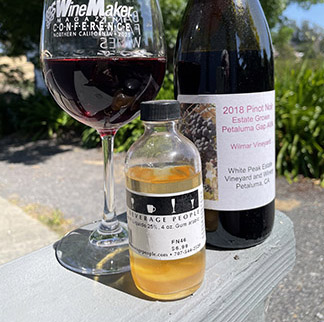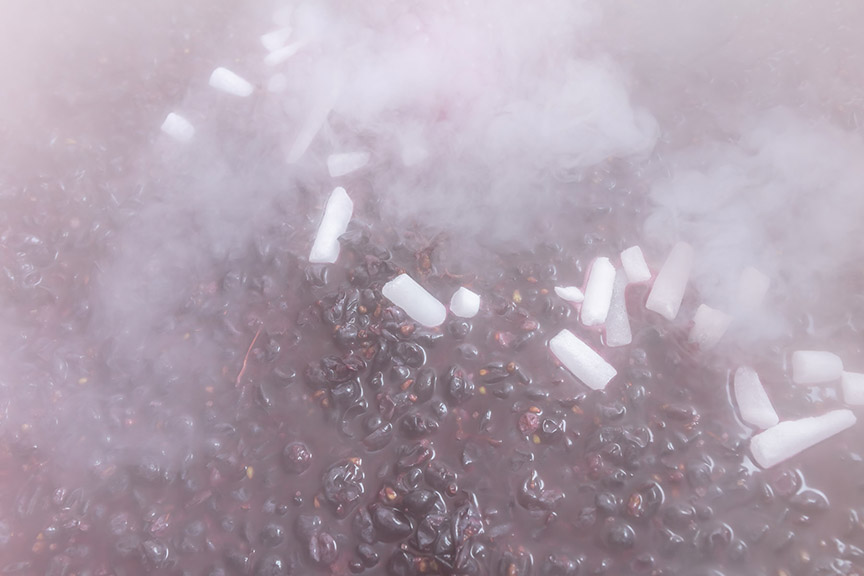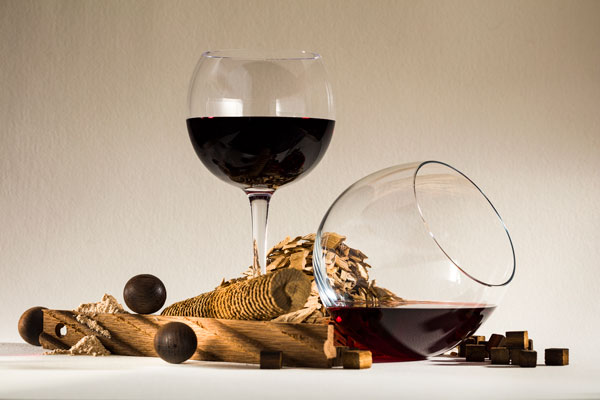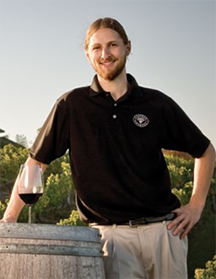Blue-Ribbon Home Winemaking Tips
Tom Petuskey
East Brunswick, New Jersey
Tom has been making wine since 1981 and has won more than 100 awards in state and national amateur wine competitions. His most recent awards were achieved from the Corrados Annual Home Wine Competition. He won a gold medal for a “méthode champenoise” apple wine made from New Jersey apples and another gold medal for a Chardonnay. These achievements also earned him the title of the James A. Corrado “Amateur Winemaker of the Year” which included an all-expense-paid trip for two to Napa Valley. Tom suggests that aspiring home winemakers follow some simple rules:
- Find the best fruit available. Tom prefers to use fresh California juice for his white wines; he also obtains premium grapes from a New Jersey vineyard. His award-winning apple wines come from cider purchased at a local orchard.
- Don’t over-sulfite your wines. Use 25 ppm SO2 at crush only if the grapes are overripe. Use no SO2 in the primary, and then only 12.5 ppm for subsequent rackings.
- During each racking, first fill the receiving containers with nitrogen gas to prevent oxidation. At bottling time, fill each bottle with nitrogen prior to filling.
- Corks should be rinsed with sulfite solution, drained and placed in a microwave at full power for one minute before they are used.
- Using the correct yeast strain is important. Tom prefers Pasteur Red or Lalvin RC212 for his red wines and Montrachet or Cote Des Blancs (Epernay 11) for his white wines. Premier Cuvee (Prise de Mousse) is preferred for finishing his sparkling wines.
- Evaluate your wines after every racking and before bottling by tasting. Get someone with a good palate to share findings so that you can make any adjustments.
Robert Edworthy
Surrey, British Columbia
Robert has been making wine with his parents since he was 13 years old. His family owns Ocean Crest Wine Club, a brew-on-premise shop near Vancouver. Rob makes wine from kits and concentrates and has won numerous awards, including first place for his dessert wine in the Canadian Nationals (sponsored by the Amateur Winemakers of Canada) and “Best of Show” for a Barbera in a national competition sponsored by the Home Wine and Beer Trade Association. Here are his top tips:
- Cleanliness is number one. I use a quarter-cup of potassium metabisulfite powder in each gallon of water to clean my equipment, then I rinse carefully so there’s no residue. Some people don’t rinse after sanitizing, but when making a kit wine, you should. Most kits come with a fairly high level of SO2. Your goal isn’t to add more, but to get it down to a low level, say 20 to 30 ppm. Above that, wine judges can taste it and it takes longer for the wine to age. Some people say it’s overkill, but rinse, rinse, rinse.
- A lot of home winemakers conduct primary fermentation in plastic pails. They add the concentrate, throw the yeast on top and leave the hole open so the lid doesn’t blow off. Air can get in; so can other stuff. Instead, I use a five-gallon carboy with a bung and blow-off hose. The hose runs into a jar filled with metabisulfite solution. This closed fermentation is a lot safer.
- Time is important. I age everything at least six months in a glass carboy before entering it into a competition. Keep the carboy nice and full by topping up.
- Yield is less important than quality. Lots of home winemakers try to make as much wine as possible from as little concentrate as possible. Don’t try to stretch your dollar this way. You’ll have wine with low flavor, light body and low alcohol. Less water is better. One of my second-place wines, a full-bodied red called Amarone, was made with a mix of juice and concentrate, plus only the water it took to rinse out the bag — maybe a liter. This won’t work on whites, by the way.
David Slight
Durham, Connecticut
David won first place at the Durham Fair, the largest fair in the state of Connecticut, with his cherry wine. He made a six-gallon batch of wine by using two 96-ounce cans of Vintner’s Harvest Cherry Fruit Wine Base and following the three-gallon recipe on the can. The result was a beautiful red-colored, crystal clear and full-bodied cherry wine. David’s tips for making fruit wine from concentrate are:
- If you want a sweet fruit wine, double the fruit that the recipe calls for but still follow the three-gallon recipe on the can; just add water to make 6 gallons.
- Use the Pasteur Champagne yeast to ferment this wine.
- Filter to render the finished wine crystal clear.
John Trapp
Paris, Illinois
John has been making wine for many years and goes to California during the winter to tour the vineyards, attend barrel tastings and speak with the winemakers. His most recent gold medal was for a Meritage (Cabernet Sauvignon, Cabernet Franc and Merlot). The blend won the Lallemand Trophy (National Amateur Wine Champion) at the Indiana State Fair “Indy International” Wine Competition. This is the third-largest competition in the country, with more than 2,500 entries. The following are his tips for championship wines.
- Purge empty barrels, carboys and bottles with nitrogen to prevent oxygen from spoiling the wine. Put the gas hose at the bottom of the vessel and let the nitrogen flow slowly into the carboy or barrel. Because nitrogen is heavier than oxygen, this inert gas will “push” all the oxygen out of the carboy, essentially replacing it. This should take about two seconds. Then immediately fill the vessel with wine. You could also use argon gas instead of nitrogen.
- Punch down the cap on fermenting must three to five times per day. Most of the nuances and the color are extracted from the skins after the eighth day of fermentation. Gradually bring the temperature up to 87° F for fermenting red wines.
- White wines should be fermented at 55° F in new French oak barrels. Use a new barrel for a white wine once, then use it for reds for the second and third year.
- To clean and store barrels: Power-wash the inside and drain. Then burn a sulfur stick in them and bung. Store in a dry place.
Rett Oren
Bethlehem, Pennsylvania
Rett has been making wine for more than 25 years and has won numerous awards for his wines on local and national levels. His specialties are white vinifera and hybrid wines. His most prestigious award was “Best of Show” for a Traminette-Gewürztraminer in the American Wine Society’s national competition. This competition is staged once a year, for AWS members only, during the national conference in November. Here are his eight key tips:
- Obtain the best fruit possible. This is the first and most important factor. Rett seeks out local sources for most of his grapes; he finds grape growers and wineries that sell fresh fruit and juice to home winemakers. He supplements with frozen grapes or refrigerated juices from the West Coast.
- Every home winemaker needs to have at least one first-rate book on winemaking principles. Rett’s favorite is “Modern Winemaking” by Philip Jackish.
- He religiously takes initial readings of Brix and titratable acidity. These measurements guide the sugar additions, yeast selection and acidity adjustments.
- White wines are fermented at cool temperatures, between 55° and 65° F. Reds are fermented warm, peaking at 85° F. All of his white wines are filtered.
- Rett spends a lot of time making final blending adjustments (with wines of different types) and with residual sugar additions. Before bottling, all of the wine is tasted many times with Rett’s wife and fellow wine lover, Priscilla. It is a great help to have another palate in these final tasting adjustments.
- Hone your wine-tasting skills. To become a better winemaker one needs to taste good wine from different regions of the world. When you taste a pleasing wine, ask yourself, “Why do I like this wine? What can I do to my wines to improve them?” Rett enrolled in the wine-tasting course offered by the American Wine Society. His level of winemaking significantly improved after this AWS course.
- Network with other winemakers. It is important to have a source of consistent feedback on one’s winemaking endeavors, whether it’s fellow winemakers in your neighborhood or friends at monthly wine tastings. Everyone has a slightly different taste spectrum. Hearing what others say about your wines can improve your wines to a wider range of tasters.
- Try to expand your horizons each year by making a least one new type of wine. One year, Rett found rhubarb in the freezer and currants in the garden. He concocted a rhubarb-currant wine that has been a hit in the neighborhood and has won prizes in contests as well. No recipe was followed. That’s what is so exciting about winemaking; each of us can make our own unique wines.
Jo Ellen Heidenreich
Pittsburgh, Pennsylvania
Jo Ellen used to work at Country Wines, a Pittsburgh supply shop that sponsors a renowned competition of its own. A member of the American Wine Society, she has won gold and bronze at the AWS national competition for French hybrids made from juice. She also has two “Best of Show” awards from the Butler County Fair and the Maryland Wine Festival. She makes wine from concentrate and fresh grapes, but mostly from juice.
- I am very particular about where I get juice. I get it from a few growers I know in Pennsylvania, plus Brehm Vineyards in California. Eastern juices may lack sugar and be high in acid. You need to learn to deal with that. It takes a little more skill to adjust acidity up front and work with it later, too. In the beginning, you only need to adjust with tartaric acid enough to make a comfortable environment for the yeast. You can fine-tune acidity later by using an acid blend or trying “cold stabilization,” which makes the tartrate crystals precipitate out.
- I went through the training program to become a certified wine judge, and it really helped my own winemaking. It taught me how to better evaluate and balance my own wines.
- Don’t be afraid to try new and interesting products. I’m now using something called glycolytic enzyme powder, which commercial wineries have long used but home winemakers are just beginning to discover. You add a quarter-gram to a five-gallon batch. It enhances varietal aromas in both reds and whites.
- Similarly, don’t be afraid to boost body with glycerin or add a little oak. Be careful with sugar, though: Undersweeten your batch if you’re adjusting sugar at the end, because it’ll taste a lot sweeter two to three days later.
Don Gauntner
Seven Valleys, Pennsylvania
Don developed an interest in the art of winemaking while serving in Germany as a career Army officer. He traveled through wine country and learned German grape-growing techniques and winemaking styles. Upon retiring from the Army in 1981, he established La Rue Vineyard in York County, Pennsylvania, where he applied these German techniques.
Don is a certified AWS judge and award-winning amateur winemaker. In 18 years of winemaking he has won more than 100 AWS awards at the national and regional competitions with three “Best of Shows.” He was also awarded the “National Amateur Wine Champion” at the Indy International. His favorite wines are the white wines of Riesling, Gewürztraminer and Scheurebe. The following are Don’s four top tips on how to make award winning wines:
- To make consistently good wine, start with quality fruit. The best way to do that is to grow your own grapes. If you can’t plant a backyard vineyard, search diligently for high-quality fruit or juice. Be sure to get precise sugar, acid and pH readings from the grower.
- Know and understand the basic measurements of winemaking: sugar, acid and pH. If these numbers are out of whack before fermentation, you won’t be able to make a well-balanced wine. It’s key to take precise measurements and adjust the juice before fermentation begins. These aren’t hard-and-fast rules, but here his general guidelines for grape harvest:
- pH: For reds, the pH should be between 3.2 and 3.4. For whites, it should be between 3.1 and 3.3.
- Acidity: The TA of whites should be between 0.70 and 0.90. The TA for reds should be between 0.65 and 0.80.
- Sugar: The Brix for whites should be between 19° and 21°. For reds, the Brix should be between 21° and 23°.
- Keep in mind that these figures are grape-variety dependent. Each variety is a bit different when determining grape maturity.
- Know and understand the differences in appearance, aroma and taste between grapes. Learn how different grapes produce different results and different styles of wine.The guidelines above, for example, vary by grape variety. For a Chardonnay, the sugar can be as high as 22° to 23° to make a better, full-bodied wine. If you’re going to make a Gamay, you may want it to be at 21°. 4. Strive to achieve a balanced wine with a good sugar-acid ratio. If your acid is in the 1.0 range and your sugar is around 19° Brix, you’re going to have an unbalanced juice, which will give you an unbalanced wine. You’ll have to adjust the juice or wine accordingly. Here’s an example: Champagne is light and crisp, because it has high acid and low sugar. But if you’re making a Riesling, something that’s fresh and fruity instead of dry and crisp, then you want to keep the acid level lower (around 0.80 to 0.83 in the finished wine) and the sugar level a bit higher (for example, one percent residual sugar).
Ray Meyer
Shepherdsville, Kentucky
Ray has been making wine for 20+ years. He makes both fruit and grape wines and grows his own grapes, fruit and berries. His favorite wines are dry reds and whites. He took “Best of Show” in the Indy International for his cherry wine. His most recent “Best of Show” ribbon was won in the Mid-South Fair in Memphis, Tennessee for his Seyval Blanc. The following are some of Ray’s tips:
- When making fruit wines, use lots of fruit. This will give the wine more body and strong fruit aromas. When you increase the fruit, be sure to take an acid reading.
- Use pectic enzyme in the must (three drops per gallon). This helps break down the pectins in the fruit so that it will be more fermentable and prevent the wine from getting a haze.
- Patience is imperative in winemaking. Of course, patience is always much easier when you have a full wine cellar.
- When using a new wine barrel, leave the fermented wine in it for two weeks and then sample every week. Remove the wine when the oak taste is to your liking.
Tom Simoneau
Healdsburg, California
Tom has been making wine since 1983. He owns the Windsor Vineyards, located in the heart of the Sonoma Valley. He plants 10 acres of grapes to sell to commercial wineries and on one acre plants the grapes that he uses for his homemade wine. Tom has won six gold medals in the Indiana State Fair for his Estate Cabernet, Shiraz, Opus, Meritage, Sangiovese and Hill Cabernet. Here are his tips for home winemakers:
- Tom picks his grapes cold and also cold-ferments his must slowly. He adds a malolactic culture at 5° to 6° Brix, when the cap has peaked. He presses off before the cap sinks, at 10° Brix. This is approximately one to two days after he has added the malolactic culture.
- He adds 50 ppm of SO2 after malolactic fermentation and racks the wine three times a year, using 20 ppm of SO2 each time. The wine finishes fermenting in French oak barrels, which he rotates each year.
- The yeast he uses for his reds is a Bordeaux style.
- Tom says that if reds are pressed at 24° to 25° Brix, they achieve cherry and fruity flavors. Blackberry flavors come through if the reds are pressed later.
Tim Vandergrift
Port Coquitlam, BC
Tim has been a home winemaker since 1988 and won numerous local awards until a few years ago, when he started judging local competitions instead of entering them. He has won three bronze, four silver and a gold medal in various international and national competitions. Several of his medals are for kit wines, which is not surprising, since he’s the former technical services manager for Winexpert, one of the leading wine-kit manufacturers in the world.
- I never leave any equipment dirty, even for a minute. I use diversol, a chlorine-based alkaline detergent that is sold under trade names like Sparkle Bright. The minute I’m done, every piece of equipment gets rinsed and cleaned. Then it’s stored either upside-down and dry, or filled with a strong metabisulfite solution.
- Pay attention to the instructions! They’re written to ensure that the kit turns out according to style. Be very wary of manipulating a kit unless you’re sure you understand the ramifications of the change.
- Build up a cellar. By that, I mean make good wine all of the time, age it properly and pull out a bottle only when it’s ready for competition. People who win awards all the time have a big cellar of properly aged wine; when it’s time for a show, they dip into their collection and pull out a bottle that may have been fine at first but has become fantastic with age.
Gene Spaziani
Mystic, Connecticut
Gene is past president of the American Wine Society and has 50 years of experience as a home winemaker. He’s the author of “The Home Winemaker’s Companion” (Storey Books, 2000) and a frequent contributor to WineMaker and helped launch the WIneMaker International Amateur Wine Competition with the magazine. He has won many awards in winemaking including the Connecticut AWS competition, where he took home “Best of Show” for a Sauvignon Blanc. He also has won “Best of Show” for his Cabernet Franc (80 percent Cab Franc, 10 percent Syrah and 10 percent Cabernet Sauvignon).
- Besides all of the usual sanitation and measuring tips, Gene says to keep grape varietals separate. Ferment them separate and do the blending at the end. For example, if you make six gallons of Cabernet Sauvignon and six gallons of Merlot you will end up with three different wines (one Cabernet Sauvignon, one Merlot and one blend). Perform bench tastings with the finished wine to come up with the blend you like the best.
Ed Turecek
Shelton, Connecticut
Ed Turecek has been making wine for over 40 years. He first started making wine with his father, who made a very dry wine from Concord grapes. Ed also makes salmonberry, blueberry, raspberry, strawberry, rhubarb, black raspberry and many other fruit wines. He has entered myriad contests at county fairs and never comes home without at least one blue ribbon. Here are some tips from this experienced winemaker:
- Never, ever use any rotten, green or windfall fruit. Choose only the best-quality fruit. Make sure it is fully ripe and at its peak.
- Always use pectic enzyme. Otherwise your wine will be hazy.
- Use Montrachet yeast to let the fruit flavors come through. It is a very clean strain.
- Use 7 to 10 pounds of apples or pears per gallon of wine. With fresh berries, use 4 to 5 pounds of berries per gallon.
- Take a hydrometer reading and add sugar until the potential alcohol is 12 percent.
- When fermenting, keep the carboys filled up to the top to keep from the wine from souring. Use a blow-off tube, if necessary, with the end in a bowl of water that has been sulfited.
- If the finished wine does not have enough fruit aroma or flavor, add natural fruit flavoring to round out the nose and palate of the wine.
Paul Dunseath
Ottawa, Canada
Paul is the past Grand Champion Home Winemaker of Canada and is a Master Wine Judge. He has won gold medals for his red and white table wines and sherry. He makes wine from grapes, frozen grapes, concentrates and juices. Here are his secrets to success:
- When Paul makes wine from concentrate, he puts it directly into a 6.5-gallon glass carboy. When the fermentation begins, it leaves a layer of carbon dioxide on top of the wine to protect it. He then racks it into a 5-gallon glass carboy when it is at 50 ppm SO2.
- He then fines the wine. If it throws off a lot of sediment, he racks it one more time.
- To make sherry, he uses a basic white wine concentrate (not Chardonnay or Gewürztraminer) and brings it up to 13 percent ABV. He adds a small amount of gypsum to increase the acid level. He puts cotton batting into the mouth of the carboy, instead of using an airlock. This enables air to reach the wine. He racks again into a 6-gallon carboy. The sherry slowly starts to darken because of the oxidation. He then puts it in his 20-year-old sherry barrel. (Author’s note: If you do not have a sherry barrel, use plain toasted oak chips. These chips can be soaked in good-quality sherry before adding them to emulate a sherry barrel.) He uses sherry yeast to ferment the sherry.
Mahlon Butz
West Lafayette, Indiana
Mahlon won a gold medal at the Indiana State Fair for his red currant wine, which is a dark, complex and intense ruby red. He has also won gold in previous years for his blended berry wine, which is a mix of raspberries, blueberries and blackberries.
- Mahlon doesn’t like his fruit wines to be too sweet, so he leaves two percent residual sugar in them and calibrates his wines so that they are 12 percent ABV. The wines are racked three times to clear them.
- Mahlon urges home winemakers to monitor their wine on a daily basis. This allows you to have control over the outcome.






